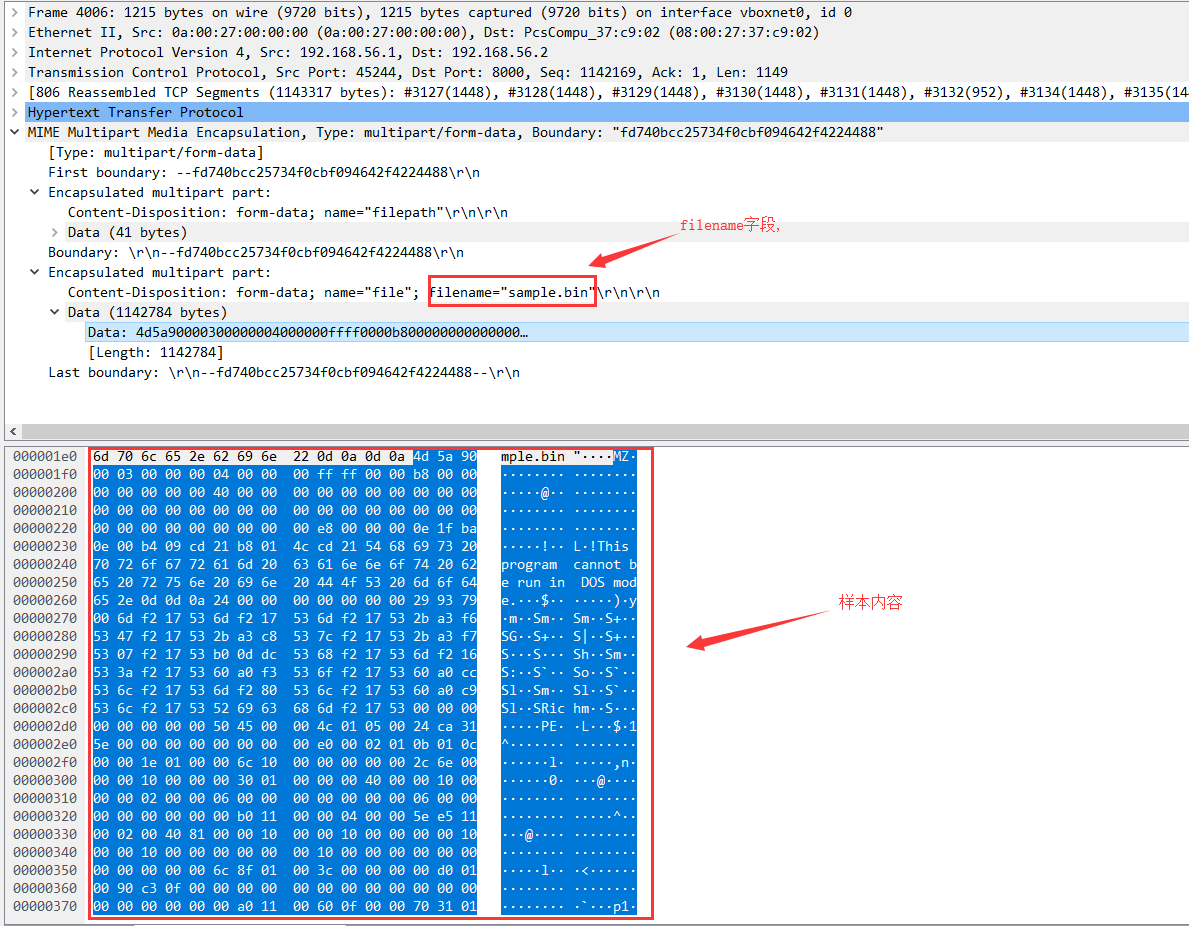
前言
中篇文章分析了host端如何开始分析(在数据库), 包括: 开启虚拟机、上传样本、上传分析模块和分析配置文件、在数据库中记录虚拟机的状态等. 下面用一张图来说明host和client端的数据传输,agent.py代码就按照这个图来进行分析.

agent中的重要类
# 继承自SimpleHTTPServer.SimpleHTTPRequestHandler, 用作对不同路径的不同函数处理(响应)
class MiniHTTPRequestHandler(SimpleHTTPServer.SimpleHTTPRequestHandler):
server_version = "Cuckoo Agent"
# 响应GET请求
def do_GET(self):
#self.client_address -> 基类中的(host, port)
request.client_ip, request.client_port = self.client_address
request.form = {}
request.files = {}
request.method = "GET"
self.httpd.handle(self)
# 响应POST请求
def do_POST(self):
environ = {
"REQUEST_METHOD": "POST",
"CONTENT_TYPE": self.headers.get("Content-Type"),
}
# host与client之间的数据传输, 格式为multipart/form-data
# 你可以理解为key:value形式
form = cgi.FieldStorage(fp=self.rfile,
headers=self.headers,
environ=environ)
request.client_ip, request.client_port = self.client_address
request.form = {}
request.files = {}
request.method = "POST"
# 遍历传输的数据格式(key:value), 将带有filename字段的内容挑选出来, 以便后面写文件.
# 如: analysis.conf, 分析模块, 样本等,这些数据在传输的时候, 都要带有filename字段
# 但不同的filename字段对应的值不一样.
if form.list:
for key in form.keys():
value = form[key]
if value.filename:
request.files[key] = value.file
else:
request.form[key] = value.value.decode("utf8")
self.httpd.handle(self)
class MiniHTTPServer(object):
def __init__(self):
self.handler = MiniHTTPRequestHandler
# Reference back to the server.
self.handler.httpd = self
self.routes = {
"GET": [],
"POST": [],
}
# 运行tcp服务器
def run(self, host="0.0.0.0", port=8000):
self.s = SocketServer.TCPServer((host, port), self.handler)
self.s.allow_reuse_address = True
self.s.serve_forever()
# route作为一个装饰器, 修饰下面步骤中函数(@app.route(...))
# self.routes:
# ["GET"] --> [(path, function), (path, function)]
# ["POST"] --> [(path, function),(path, function)]
def route(self, path, methods=["GET"]):
def register(fn):
for method in methods:
self.routes[method].append((re.compile(path + "$"), fn))
return fn
return register
# 执行相应的处理函数
def handle(self, obj):
if "client_ip" in state and request.client_ip != state["client_ip"]:
if request.client_ip != "127.0.0.1":
return
if obj.path != "/status" or request.method != "POST":
return
# obj.command --> post or get
# obj.path -> GET /path or POST /path
for route, fn in self.routes[obj.command]:
if route.match(obj.path):
ret = fn()
break
else:
ret = json_error(404, message="Route not found")
ret.init()
obj.send_response(ret.status_code)
ret.headers(obj)
obj.end_headers()
if isinstance(ret, jsonify):
obj.wfile.write(ret.json())
elif isinstance(ret, send_file):
ret.write(obj.wfile)
def shutdown(self):
# BaseServer also features a .shutdown() method, but you can't use
# that from the same thread as that will deadlock the whole thing.
self.s._BaseServer__shutdown_request = True
开机自启动
在进行cuckoo沙箱安装的时候, 需要将ageng.py拷贝至Windows的Startup文件夹, 并且修改后缀py为pyw, 实现开机自启动.
获取agent.py基本信息
浏览器输入
192.168.56.2:8000, 返回, 获取agent的一些基本信息.{"message": "Cuckoo Agent!", "version": "0.10", "features": ["execpy", "pinning", "logs", "largefile", "unicodepath"]}
AGENT_VERSION = "0.10"
AGENT_FEATURES = [
"execpy", "pinning", "logs", "largefile", "unicodepath",
]
# app = MiniHTTPServer()
# 以json格式返回基本信息
@app.route("/")
def get_index():
return json_success(
"Cuckoo Agent!", version=AGENT_VERSION, features=AGENT_FEATURES
)
是否固定ip
个人感觉没啥用, 既然已经能获取基本信息, 说明ip和端口都是正确的, 已经被固定使用了.
@app.route("/pinning")
def do_pinning():
if "client_ip" in state:
return json_error(500, "Agent has already been pinned to an IP!")
state["client_ip"] = request.client_ip
return json_success("Successfully pinned Agent",
client_ip=request.client_ip)
获取环境变量
获取client端环境变量,以便后面后续的一些命令执行.
- mkdtemp
- extract
- store
- execpy
@app.route("/environ")
def get_environ():
return json_success("Environment variables", environ=dict(os.environ))
创建临时文件夹
其实ageng.py中存在两个创建临时文件夹的命令: mktemp和mkdtemp. 但二者创建的位置不一样:
- mkdtemp --> 在%SYSTEMDRIVE%(C:\)下创建一个随机文件夹
- mktemp --> 在%TEMP%(C:\Users\bill\AppData\Local\Temp)下创建一个随机文件夹
@app.route("/mktemp", methods=["GET", "POST"])
def do_mktemp():
# 我抓的包中, 没有发现suffix和prefix这两个字段.
# %TEMP%(C:\\Users\\bill\\AppData\\Local\\Temp)
suffix = request.form.get("suffix", "")
prefix = request.form.get("prefix", "tmp")
dirpath = request.form.get("dirpath")
try:
fd, filepath = tempfile.mkstemp(suffix=suffix, prefix=prefix, dir=dirpath)
except:
return json_exception("Error creating temporary file")
os.close(fd)
return json_success("Successfully created temporary file",
filepath=filepath)
@app.route("/mkdtemp", methods=["GET", "POST"])
def do_mkdtemp():
# 我抓的包中, 没有发现suffix和prefix这两个字段.
# %SYSTEMDRIVE%(C:\\)
suffix = request.form.get("suffix", "")
prefix = request.form.get("prefix", "tmp")
dirpath = request.form.get("dirpath")
try:
dirpath = tempfile.mkdtemp(suffix=suffix, prefix=prefix, dir=dirpath)
except:
return json_exception("Error creating temporary directory")
return json_success("Successfully created temporary directory",
dirpath=dirpath)
上传分析模块
中篇中提到,将分析模块以zip格式压缩,发送给client端. 发送extrac命令, 将分析模块解压到上一步创建的文件夹中.
@app.route("/extract", methods=["POST"])
def do_extract():
# 上一步创建的随机文件夹C:\\tmppx7scxC:tmppx7scx
if "dirpath" not in request.form:
return json_error(400, "No dirpath has been provided")
if "zipfile" not in request.files:
return json_error(400, "No zip file has been provided")
try:
with zipfile.ZipFile(request.files["zipfile"], "r") as archive:
archive.extractall(request.form["dirpath"])
except:
return json_exception("Error extracting zip file")
return json_success("Successfully extracted zip file")
上传分析配置文件analysis.conf
执行store命令, 写入analysis.conf
@app.route("/store", methods=["POST"])
def do_store():
# filepath: C:/tmppx7scx/analysis.conf
if "filepath" not in request.form:
return json_error(400, "No filepath has been provided")
# file: analysis.conf
if "file" not in request.files:
return json_error(400, "No file has been provided")
try:
with open(request.form["filepath"], "wb") as f:
shutil.copyfileobj(request.files["file"], f, 10*1024*1024)
except:
return json_exception("Error storing file")
return json_success("Successfully stored file")
analysis.conf内容
[analysis] category = file target = /tmp/cuckoo-tmp-pwnmelife/tmpZ3SA0v/maze.exe (host端的样本地址) package = exe file_type = PE32 executable (GUI) Intel 80386, for MS Windows file_name = maze.exe clock = 20200620T09:28:00 id = 1 terminate_processes = False options = apk_entry=:,procmemdump=yes,route=none enforce_timeout = False timeout = 120 ip = 192.168.56.1 pe_exports = port = 2042
上传样本
执行store命令, 写入maze.exe
@app.route("/store", methods=["POST"])
def do_store():
# filepath: C:\Users\bill\AppData\Local\Temp\maze.exe
if "filepath" not in request.form:
return json_error(400, "No filepath has been provided")
# file: sample.bin
if "file" not in request.files:
return json_error(400, "No file has been provided")
try:
with open(request.form["filepath"], "wb") as f:
shutil.copyfileobj(request.files["file"], f, 10*1024*1024)
except:
return json_exception("Error storing file")
return json_success("Successfully stored file")
执行分析脚本
def do_execpy():
# filepath: C:/tmppx7scx/analyzer.py
if "filepath" not in request.form:
return json_error(400, "No Python file has been provided")
# Execute the command asynchronously? As a shell command?
# async: yes
async = "async" in request.form
# cwd : C:/tmppx7scx
cwd = request.form.get("cwd")
stdout = stderr = None
args = [
sys.executable,
request.form["filepath"],
]
# async = yes, 不返回执行结果
# async = false, 返回执行结果
try:
if async:
subprocess.Popen(args, cwd=cwd)
else:
p = subprocess.Popen(args, cwd=cwd,
stdout=subprocess.PIPE,
stderr=subprocess.PIPE)
stdout, stderr = p.communicate()
except:
return json_exception("Error executing command")
return json_success("Successfully executed command",
stdout=stdout, stderr=stderr)
不断获取样本分析状态
当返回complete状态时, host端要关闭虚拟机.
@app.route("/status")
def get_status():
return json_success("Analysis status",
status=state.get("status"),
description=state.get("description"))

[培训]《安卓高级研修班(网课)》9月班开始招生!挑战极限、工资翻倍!
最后于 1小时前 被baolongshou编辑 ,原因:
文章来源: https://bbs.pediy.com/thread-260252.htm
如有侵权请联系:admin#unsafe.sh
如有侵权请联系:admin#unsafe.sh